ALASKA
August
27–September 17, 2008
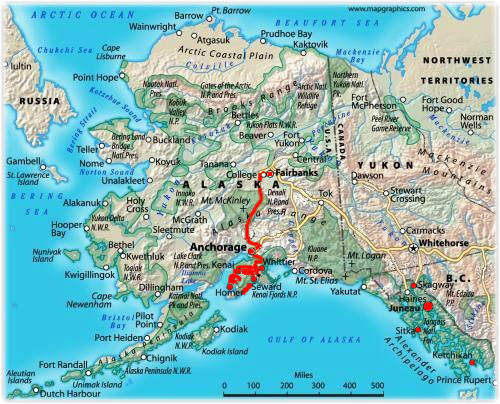 THE BIG
PICTURE
THE BIG
PICTURE
The Last Frontier. Land of the
Midnight Sun. The Far North. Seward’s Ice Box.
Whatever images such names
conjure in your mind, there’s no denying the mystique of Alaska,
something that draws one to wonder about what’s there, about why people
went there and why they stayed. What is “home” that people find there?
Is there more than a vast, untamed wilderness populated with wild
animals, mountains and glaciers, and snow and ice as far as the eye can
see? And a pipeline that runs through it all?
We wanted to see for ourselves,
so we planned a broad, overview tour
of Alaska’s
understandably most popular areas. We traveled by airplane, cruise
ship,
tour boat, train, RV, car, horseback, single-engine plane, and
helicopter, plus a good share of urban walking and mountain hiking. Our
itinerary took us from home to Vancouver, BC, where we began our cruise
through the Inside
Passage (Ketchikan, Juneau, Skagway and Sitka) to
Whittier. In Anchorage we rented an RV
and drove throughout the Kenai Peninsula (Seward and Homer) and back to
Anchorage. Then we drove with friends to Fairbanks and Denali (Mt.
McKinley) National Park,
and back to Anchorage from where we
flew home to Denver. Though we did and saw a lot in our three weeks, as
you can see from the map (the red dots and
lines are where we went), we left much of the
state to explore on another trip.
I.
CRUISING THE INSIDE PASSAGE
Judy had never been to Alaska and
really wanted to
go; our son, Michael, had gone with me in 1983 when I did a week of
storytelling
and a college
mini-course in Anchorage; I looked forward to returning. Our first
thought was to drive our RV, possibly combining the drive with the
Marine Highway (Blue
Canoes). The estimated cost with the RV on the ferry system
was quite high and would require complex arrangements. Doable, but
difficult—and expensive.
As much as the images of
thousands of tourists we’ve
observed being disgorged from cruise ships in the Caribbean had
always given us serious discomfort, we concluded that cruising the
Inside
Passage was the most economical and, in the end, the most restful
and
perhaps the most enjoyable way to see the towns, the glaciers, the
wildlife, and the landscape of southeast Alaska. Besides, we’ve never
taken a cruise and most people we talked with said we’d enjoy it.
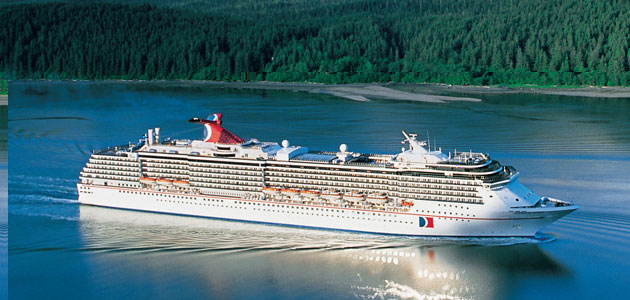
Well, we did.
We chose the Carnival “Spirit”
for the timing of the trip, the
ports of call, and the low fare. The information we were able to
dig up led us to believe, in general,
that Alaska cruise ships go to
the same ports (Sitka is not on every itinerary), offer the same
entertainment, same food, same services,
have the same accommodations, and are probably owned by the same parent
company. The Carnival Spirit is big and one of the longest cruise
ships to run the Inside Passage. It has 12 decks, a staff of over 900
(which speaks up to 60 languages) who serve just over 2100 passengers,
though we were not full. A daily schedule of dozens of on-board
activities—contests, games, lectures, movies, dancing, special sales,
to say nothing of the swimming pools, spas, casinos, drinking, and
shopping, all designed to keep passengers from being bored while
“confined” to the ship—was
announced daily in the newsletter delivered to the room each evening.
We had a splendid time. We we may
have eaten a
little too much too
often (at least I did); we scheduled 6:30 am room service
“pre-breakfasts”
(coffee, juice/fruit, lox and bagels, or something similar) each
morning, then Judy ran her five miles while I rode a stationary bike
and played with the exercise equipment. We’d have breakfast before
leaving the boat for tours on shore. While on board, we attended
excellent lectures by
the ship’s biologist/naturalist, watched great live musical
entertainment each night, ate outstanding dinners served up by young
Paul, our very entertaining hotshot waiter from Peru (he had a few card
tricks and remembered our names and special preferences from the first
night on!). We had two days entirely “at sea” including the last day
when we sailed through Prince William Sound to view dozens of glaciers
up close.
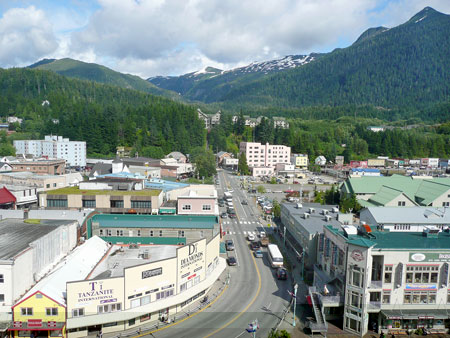 As much as we enjoyed our time on
board, we spent all the time we could off the ship when we pulled into
one of the four
ports on the itinerary. The four shore excursions will be what we
will remember most from our week on the Inside Passage.
As much as we enjoyed our time on
board, we spent all the time we could off the ship when we pulled into
one of the four
ports on the itinerary. The four shore excursions will be what we
will remember most from our week on the Inside Passage.
•Ketchikan.
We had booked a flight with
Family Air Tours to fly us
over and through Misty Fiords
National
Monument and the Tongass
National Forest, the largest of our country’s
National Forests. After a brief walk around the small town of Ketchikan
as soon as we left the ship, we hooked up with Dave Rocke, a very
congenial fellow who would fly us and two others (a fellow from Seattle
and his son) in his single-engine Cessna 183 for a three-hour flight
south of town over Revillagigedo
Island into areas where only boats and
small planes can reach. The weather for the flight was the kind the
Ketchikan Chamber of Commerce dreams of. In
fact, Dave said it was one of the five sunny days they’ve had all year.
In our fly-over we saw densely forested islands and deep fiords, ice
fields and
snow covered jagged peaks that were too tall (over 4,000') to be ground
down by the glaciers, and fresh water lakes, some with thick muskeg and
teeming with trout and salmon. Dave set the plane down on one of the
lakes so we could stretch our legs and poke around briefly. On the
return flight
we saw eagles, bears, and Dall sheep, those snow white, sure-footed
daredevils that hang precariously to the mountainsides. This was an
excellent trip and we enjoyed the scenery and Dave’s commentary
throughout.
In the afternoon, we made our way
to Creek Street,
the former red-light district that’s been done over for tourists with
trendy shops that sell souvenir clothing, salmon, shot glasses. We’re
sorry we spent any time there at
all. We walked to the other end of town to the Totem
Heritage Museum
that houses relics and historical photos of Haida and Tlingit villages
that were abandoned in the 19th century. The totems displayed were
badly rotted, but the history in the photos was worth the visit: a real
glimpse of native village life at the time of contact with Europeans.
On the way back to the ship we walked along the Ketchikan River, so
thick with spawning salmon you could almost walk across without getting
your feet wet.
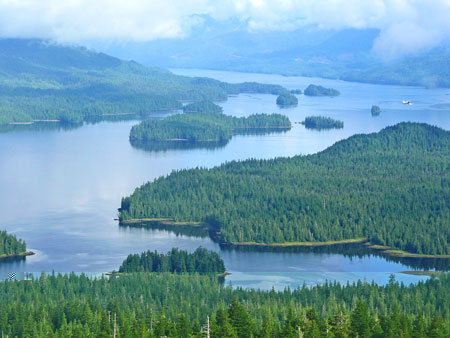
We agreed we don’t need to see
Ketchikan again. It’s
small enough to walk most of the town and see the same jewelry, salmon,
jade, tanzanite, clothing, and diamonds that are found at each of the
ports, as well as on board the ship (the cruise line operates many of
these stores). A notable exception in Ketchikan’s retail line-up is a
“chain,” called the Tongass stores: one for business supplies, for
hardware,
and for sporting goods. These are “real” stores like we’d like to have
in our town, stores that remind us that real people live here year
round and are not part of the cruise ship line-up of phony retail
opportunities. If the cruise ship industry should by-pass Ketchikan,
only salmon fishing would survive to support the town (as it did
originally).
•Juneau. Before we left home we had
made arrangements for a
helicopter trip and hike on the Juneau
Icefield through NorthStar
Trekking. When we arrived in Juneau,
the clouds were low and there was
a light rain/drizzle. We were not sure if we would make the trip
because of the weather.
However, we got picked up on time at the Red Dog Saloon (a downtown
landmark of unearned reputation as a really “hot” place to visit on a
Saturday night) and driven to the Juneau airport where we, along with
four others, switched into ice hiking gear and climbed aboard the small
helicopter. Our trip up the Mendenhall
Glacier and beyond to the
icefield itself was smooth and the views breathtaking. It simply didn’t
last long enough.
We landed at a
semi-permanent camp where we
met our guide, Dulcie, who led us on a tour of the icefield’s surface,
which not only featured deep crevasses but to our surprise, lots of
rivers crisscrossing what we thought would be a smooth surface. Shortly
after we
started out, she told us to empty the bottled water we were given with
our gear and refill our bottles with running glacier
water. We both tasted the bottled water before we emptied them
and found the glacier water much sweet and more refreshing.
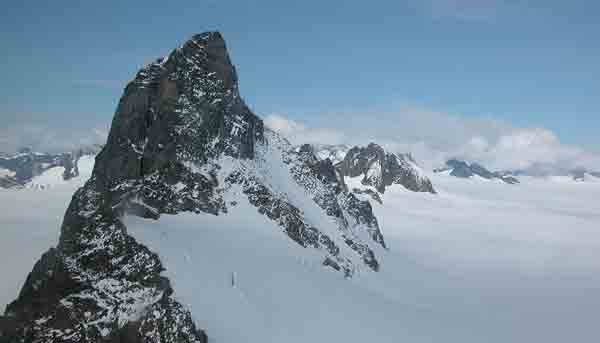
The weather on the icefield was
sunny and warm,
especially bundled, as we were, into windproof pants and jacket on top
of our regular clothing. The boots and crampons both helped us move
safely on the slick surface, but took some getting used to. You can’t
drag your feet. We hiked for about an hour, leaping
across rivers and ice cracks and taking lots of pictures.
After the hike, we shared a table
with fellow
icefield trekkers Kelly and Pam at The Hanger, a bit of a
“joint” that lived up to
its stellar reputation as a place for outstanding fish
and chips with cold Alaska Amber on tap (recommended by both the
NorthStar staff and Fodor’s as a “not-to-miss” eatery in Juneau). It
was relaxing and refreshing, as well as tasty, after our afternoon on
the ice.
We returned to the ship for
dinner (though we were
not particularly hungry) then left again to mail postcards and
pay a visit to the much-publicized Red Dog Saloon. After all, it was
Saturday night. We walked into the Red Dog about 8:30 and thought we’d
mistakenly found the Juneau morgue: There were six or seven dour
looking folks sucking on longnecks at the bar
waiting for something to happen. We don’t think it was going to. What a
bust!
•Skagway. The “good” weather followed us
to Skagway: no rain, low clouds,
and a bit cooler, but still fine
weather for this part of the country at this time of the year. This
seemed
the most “authentic” town we’d visited so far. It has not been
completely bought out by the cruise lines: stores have “real”
merchandise in addition to souvenirs; there is a good deal of native
art alongside the tanzanite and “mystic topaz” stuff. We walked
throughout the small town: neighborhoods where the year round folks
live, along the main street shops, through the town museum with its
emphasis on gold rush history along with native arts. (Most of the town
is part of the Klondike National
Historic Park; the National Park
Service hosts daily walking tours of the area.) The landscape of the
narrow valley shadowed by sharp peaks on three sides away from the
harbor seems very reminiscent of areas of Colorado, New Zealand, and
Switzerland, except for the ocean, of course.

The fabled Chilcoot (or
Chilkoot) Pass
(known to every Alaskan schoolchild and made famous most recently
by its depiction on Alaska license plates) originated at the
nearly deserted town of Dyea just a few miles away from Skagway.
Crossing the pass was a terrible
trek for unprepared “stampeders” from the lower 48 to make in their mad
rush to the Yukon River and the Klondike on the other side. It was
called “the 32 meanest miles in the world.” Only one in ten who
set out up the trail made it to the other side.
Nearby White Pass
was also treacherous, but when the railroad was soon
built over the original wagon road in 1898, Chilcoot Pass was abandoned
to the folklore of Alaska history as a symbol of the true
hardships men, women, children, and animals suffered to get from the
ocean to the Yukon River and the gold fields near Dawson and beyond.
(The tragedy was, of course, that by the time most folks got there, the
best claims were long taken and most of the survivors of the original
Chilcoot Pass trek were to be disappointed and out of luck.)
We had booked passage on the
four-hour train ride to
the top of White Pass on the White Pass and Yukon Railroad
and had good weather and a comfortable ride. We
never saw Chilcoot Pass, though we suspect it looks a lot like the
White Pass road.
[Note: The
town of Haines (population about 2,500) lies just across the inlet from
Skagway, though the towns are not visible to each other and no road
connects them. Outside
Magazine named Haines as one of the top 10 places to live if you
didn’t
have to make a living. We’ve enjoyed Heather Lende’s If You Lived Here,
I’d Know Your Name (Algonquin, 2005), which paints a vivid and
loving portrait of this
scenic town. We’ll be sure to go there if we ever drive north.]
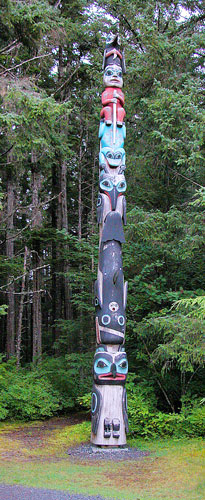
•Sitka. Our first
rainy day—the first
of many to come—but our spirits were high because we were looking
forward to a tour with Dave
Lubin aboard his sturdy Esther G.
south
along the inlets and jagged coastline and out into Sitka Sound in
search of humpback whales, orcas, sea otters, and other sea life. A
little rain would not dampen our spirits.
Because of the shallow port area,
not all cruise
ships stop at Sitka and those that
do anchor offshore and shuttle
passengers to and from the big ships. We used the morning to
walk to the top of Castle
Hill, where the Russians officially turned
Alaska over to the USA and remained its first capital for a short
while. We walked through the town of 8,000 that seemed to defy the
cruise line image: there were fewer glitzy tourist stores and they were
mixed in with Radio
Shack and MacDonald’s;
St. Michael’s Cathedral (Russian Orthodox)
stood
proudly in the center of town; it was built in 1862, destroyed by fire
in 1966, and rebuilt soon
thereafter. Sitka’s Pioneer Home,
now a facility for seniors, stands out at the port entrance
to town, and Sheldon
Jackson College only recently suspended their
academic programs.
We walked to the “end” of town to
Sitka National
Historic Park where we strolled along the short but beautiful Totem
Trail through the dense forest of Sitka spruce and western hemlocks
to the site of the Battle
of 1804 where the Russians were, briefly,
held off by defiant Tlingits in a decisive battle that gave Russia, at
least in their minds, control of all Alaska. The totems placed
throughout the dense forest are from other abandoned native
villages. A totem carver and a silversmith were at work in the
visitor’s center studios.
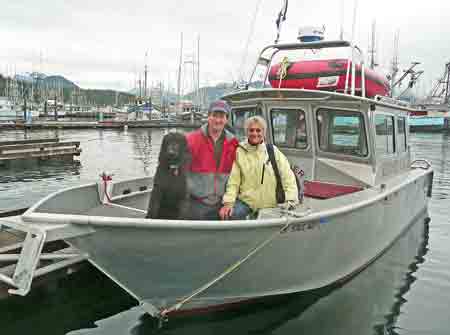
We met Dave Lubin and his poodle,
Louie, on schedule
at the main pier in town. The other couple who was scheduled to be on
the trip canceled at the last minute (Davey was told they had “a rough
go of things the night
before”) so we had Davey and Louie and the Esther G to ourselves for the next 3–4
hours.
We cruised south from Sitka
through a labyrinth of inlets and islands
in search of sea otters (we saw a few), seals (we saw many groups), and
sea lions (some were just off shore from the pier), eagles (lots in
some areas), and jellyfish (hundreds in an area of confluence of fresh
and sea water). Then we headed out into “the zone” in Sitka Sound eight
to ten miles off shore where we saw half a dozen humpback whales up
close. We considered it a successful trip, not to be missed. We
especially enjoyed Dave Lubin’s knowledgeable and passionate commentary
on the history of the area and the respect he has for the
area’s environment.
We returned to the Spirit for a
rest, a fine
dinner, and an early evening getaway that would take into fairly rough
seas that continued throughout the night. The musical revue planned for
that evening was canceled for the safety of the dancers!
•The Glaciers of Prince
William Sound.
Our last
day and night of the cruise were spent at sea. Because the ship
continued to “rock
and roll” a bit, Judy decided not to risk running on a wet deck. Later
in the morning the sun finally showed itself, but not for long. The
drizzle kept us indoors and we focused on the several tasks in
preparation
for disembarking first thing in the morning.
During the dinner hour we passed
into the College
Fjord Glaciers area. We cruised by the Vassar, Smith, and other
glaciers until
finally nosing slowly up to the Harvard Glacier as close
as a huge vessel can come and still be able to turn around. It would
have been spectacular on a sunny
day!
II. THE
KENAI PENINSULA BY RV
[Note: One of our first purchases to
help plan our trip was the latest copy of The Milepost,
which describes in great detail every item of even passing interest
along every mile of roads not only in Alaska but on main roads leading
to
Alaska through Alberta, British Columbia, the Yukon, and Northwest
Territories, though the Canadian sections are less detailed. At
$27.95 (you can usually get a 30% discount through amazon.com) this
is a must-have resource for anyone who gets behind the wheel of any
vehicle (or is a passenger in a vehicle). It also includes information
about the Alaska Marine Highway (Blue Canoes) and other ferries along
the coast, and the Alaska Railroad. This 800-page volume offers
suggested itineraries both
getting to and while driving in Alaska, and includes useful phone
numbers,
addresses, email and websites for facilities throughout the region. Buy
it before you go as a planning resource and, as they used to say—and
it’s even truer with The Milepost—Don’t
Leave Home Without It.]
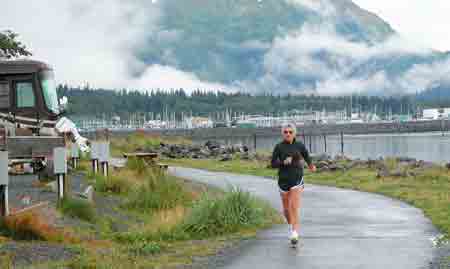
•Seward. We
left the cruise ship in Whittier
in a downpour and rode the bus an hour
to Anchorage and Great
Alaskan Holiday where we picked up our home for
the next eight days: a 28’ Winnebago. We headed straight for Seward,
shopped at the local Safeway for a few days of groceries, and spent the
night at the city campground on the shore of Resurrection Bay. The
spectacular setting would have been enhanced only by sunny weather: the
snow covered peaks across the water emerged from wispy clouds to nearly
4000' above the bay. Behind us was the town and above it Mount
Marathon, the site of a July 4th run we missed by nearly two months.
Dinner at Ray’s
Waterfront Restaurant at the boat harbor was excellent: fresh
baked salmon, fish and chips, and, best of all, seafood chowder. As we
walked, after dinner, along the paved path that skirts the waterfront,
we watched a lone sea otter as he floated on his back chomping on his
dinner of shellfish he’d brought up from the bottom. It was quite a
show, one we’d enjoy the next morning as well.
Judy ran along the waterfront
after the early
morning rain finally stopped. That morning we arranged for an all-day
boat
tour of Kenai Fjords National Park
for the next day, and then drove a
few miles out of town to hike to Exit
Glacier that “flows” from the
massive Harding
Icefield. The Exit Glacier is one of the few glaciers accessible by
car. The trail to the side and toe of the glacier is a short two-mile
walk, and we appreciated the chance to see a glacier that close. On the
way back to Seward we selected a place to spend the night parked in a
large pullout on the Exit Glacier road.
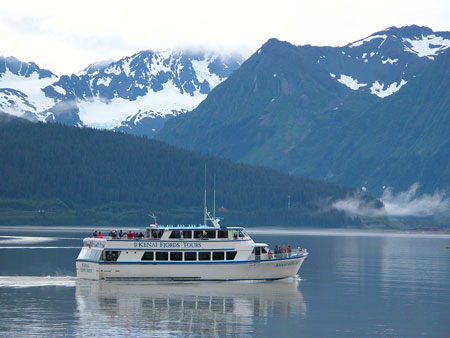
[Note: Alaskans and visitors both
take advantage of
highway pullouts to park for a night. As long as there is not a “No
Camping” sign and the road is in the National Forest, such parking is
permitted and, apparently, as safe as parking in a Wal-Mart lot.]
When we returned to Seward, we
spent the afternoon
walking through the town, mailed a few postcards, then finished the day
at the Alaska
Sealife Center, a marvelous facility for seeing and
learning about wildlife native to Resurrection Bay. There are excellent
exhibits of sea birds (puffins, ducks, etc.) mammals (sea lions, seals,
and sea otters) and fish of all sorts. It is a zoo, of course, but all
the animals were found either injured or abandoned and will live out
their lives in the Center.
•Kenai
Fjords
National Park. We had
planned an all-day cruise along the
coastline of this incredible national park with the Kenai Fjords Tours,
one of at least three tour companies operating out of Seward. The
experience was excellent: the opportunity to see the scenery, the
wildlife, and the glaciers was all outstanding. The commentary by Dan
Olson, Captain of the Misty
(see photo on right) and a graduate of
Boulder’s Circus Center
(!), was informative and always interesting. We
were comfortable and dry, except when we chose to venture outside
during
one of the many periods of rain that day.
We cruised south out of
Resurrection Bay, stopped by
Fox Island to drop off some day hikers on the other side of the Bay,
skirted the Gulf of Alaska, rounded Aialak Cape, passed through Granite
Passage, and sailed into Northwestern Fjord. Along the way we saw Stellar sea
lions who lolled on rocks incredibly high above the water line
(Unlike seals,
sea lions have long front flippers which permit them to climb, with
some effort, high on rocks; seals don’t have the physical make-up to
match sea lions.); sea otters,
like our friend at the Seward
waterfront; harbor seals
that littered ice chunks fronting
glaciers; Dall’s (or
Dall) porpoises (named for the same William
Healey Dall, the American naturalist who
gave his name to the rock-hugging sheep of Alaska); great numbers of
both tufted and horned puffins,
which we’d seen up close at the SeaLife
Center the day before; and humpback
whales that Capt. Dan steered us
toward as they were spotted (no breaching, but flukes and diving).

When we finally entered
Northwestern Fjord, we glided
past several smaller glaciers along the side of the fjord and nosed
slowly through a field of icebergs/ice chunks that grew larger and
carried more seals as we approached the Northwestern
Glacier. Capt. Dan
nosed us into the face the glacier so that we could begin to grasp the
massive size and height of the ice. It did calve a few times, but too
quickly to catch a picture of the event. The low lying clouds, claimed
Capt. Dan, was of great benefit to our enjoyment of the trip since, he
said, as more animals come out in non-sunny weather and the glacial ice
always appears bluer. So he said.
[Note: We should not have been as
surprised as we
were to learn that Capt. Dan lived in Boulder one summer and had put
his bike on an RTD bus and headed for Nederland for some high country
mountain biking. Between Judy’s running and my “Boulder
Race Series 2003” baseball hat, we talked with many folks throughout
our trip who knew Boulder, the Bolder-Boulder 10K, and nearby
Nederland. Among travelers, the world is small and personal connections
are easily made.]
•Homer. We spent the
next
night at Quartz Creek Campground, near Cooper Landing. This
lovely
campground is located where the Kenai River flows into Kenai Lake (take
your choice of a lakefront or riverfront site). Judy got up for a
pre-breakfast run and I walked down to the lakefront where I discovered
a large group of people assembling for a rowing regatta with teams
from Anchorage, Seward, and the Kenai competing on a
triangular
course on the lake. We stayed for a few races and then pulled out
mid-morning for Soldotna
(groceries and gas [$4.44/gallon] at a Fred
Meyers store. The gas pump there is programmed to restrict pumping more
than $125; we could not fill up the RV!); Kenai (a
charming Russian church still standing and a
great visitor’s center, but little else to make us want to linger); and
south
through Kasilof
(where is town?); Clam Gulch
(more razor clams than people);
Ninilchik
(a retirement village for Russian settlers with a very
picturesque Orthodox church and cemetery—see photo); Anchor Point (not much
there); and finally to our destination: Homer.
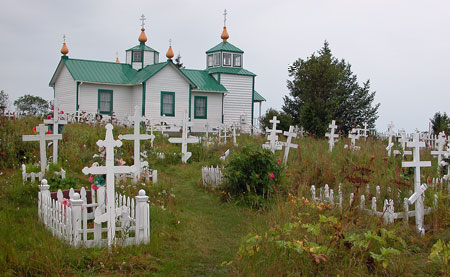
We drove straight through the
small town and out
onto the famous Homer
Spit, four miles of paved road atop glacial moraine that has
drawn fishermen, hippies, and folks just looking for the end of the
road (see photo below).
By this time, Labor Day had come and gone, and many businesses and
charters had closed for the season or had curtailed services. Captain
Pattie’s, noted by locals and some travel guide gurus for great chowder
made
with razor clams, was open and we gave it a try. (The chowder was, to
be generous, only so-so. We were to have the best chowder of our trip a
few days later at The Sourdough
Express just off the Spit in town: fresh pastries, breads, and
sandwiches,
as well as
great chowder.) We spent the night in the city’s Karen Hornaday
Memorial Park above the town, which offered some protection from the
wind and rain.
[Note: Our
best advice: Don’t
come to Alaska before June 1 or after Labor Day. Yes, there will be
more visitors and traffic, but all businesses will be up and
running—and the prices will be the same. Plus, it will be drier!]
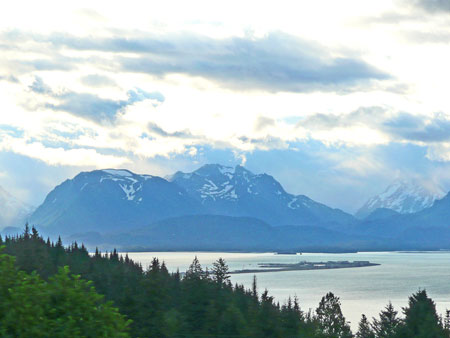 The next
morning we read the Sunday paper and drank
our coffee in the Safeway parking lot, waiting for the Pratt Museum to
open at 10:00. The Pratt has excellent displays—videos as well as art,
photos,
and artifacts—of native history, sea life, the Exxon oil spill, and
other aspects of life around Homer and Kachemak Bay. The docent at the
adjoining pioneer cabin was entertaining as well as informative. All in
all it was time well spent. The few art galleries open were worth the
visit, as was a heath food store on the main street.
The next
morning we read the Sunday paper and drank
our coffee in the Safeway parking lot, waiting for the Pratt Museum to
open at 10:00. The Pratt has excellent displays—videos as well as art,
photos,
and artifacts—of native history, sea life, the Exxon oil spill, and
other aspects of life around Homer and Kachemak Bay. The docent at the
adjoining pioneer cabin was entertaining as well as informative. All in
all it was time well spent. The few art galleries open were worth the
visit, as was a heath food store on the main street.
Our intention to camp on the Spit
for the next few
nights got off to a bumpy (and expensive) start when I got the RV stuck
in a very soft/sandy parking area of an RV park. After a fellow camper
and two passers-by tried to help dig or pull me out, it took Big Alaska
Tow’s powerful winch to pull it out. After that we settled for dry
camping on firmer ground at the town campground on the Spit. After
settling in at last,
Judy went
for a run toward town along the Spit (about four miles round trip).
Afterward, we paid a visit to the “famous” Salty Dawg Saloon to check
out the thousands of dollar bills tacked to the walls and ceiling of
this smokehouse masquerading as a bar. Like the Red Dog Saloon in
Juneau, the establishment’s reputation far outshines the reality. Don’t
bother unless you need a second hand smoke fix.
The next day we had a date with
Mark Marette, the
only cowboy for 1,000 miles and, according to Dana Priest of the
Washington Post (August 3,
2008), the last of the Marlborough men. As
it turned out, she was not far off. We had called him a few days before
to set up a most-of-the-day trail ride along the upper reaches of
Kachemak Bay.
Mark’s place is about eleven
miles north and east of
Homer. We were at his place by 8:30 in the morning
along with another
couple, jumped in his pickup with a horse trailer in tow, and headed
further on until the pavement ended and the road took a serious descent
down to the shoreline. Mark parked at a Russian Church at the top of
that hill and we rode our horses down and onto the shoreline toward the
head of the Bay. We crossed several streams feeding into the Bay (some
too deep to keep our feet in the stirrups) and passed by several
“Russian” villages and homesteads. Mark explained that these Russians
were believers in the “old religion” and were relatively new immigrants
to Alaska (unlike those who are descendants of the original Russian
settlers or immigrants fleeing Russia in the early 20th
century for
political reasons.) These new immigrants keep themselves separate from
other Alaskans,
have their own schools, speak Russian as their first language, and
maintain, as much as possible, their cultural distinctions.
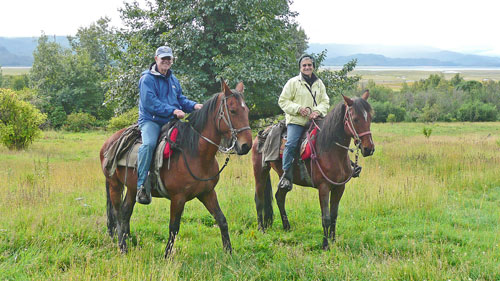
We rode about five miles to a
place once homesteaded
by a group of what Mark referred to as “Barefooters,” a religious sect
called
the Fountain of the World who originated in
California led by Krishna
Venta who was killed by outraged/jealous husbands of sect members
in 1958. (I remember the newspaper articles when I was growing up in
Ventura County in southern California.) Some of
his
followers, including his “wife,” Ruth, had come to homestead this
attractive isolated area to live off the land (and keep
their feet bare as they had in SoCal, apparently.) They sort of
dissolved following Krishna Venta’s murder and the land returned
to the state. (More information about the sect
can be found at CharlieManson.com, if that gives you any idea about the
nature of the group in its day.) We stopped there for a picnic
lunch. On the way back, the trail passed through a woodsy area with a
distinctive odor:
the horses and Mark, then the rest of us caught the scent. Mark leapt
off his horse, drew his six-shooter and dashed into the woods yelling,
“Bear! Bear! Bear!” (to scare the bear, not call it out—or maybe part
of the show). What he found
was the carcass of a moose that most likely had been killed and eaten,
in part, by a bear. We verified the recent presence of a bear by very
fresh
prints in the mud on the trail.
[Note: While
I found Mark’s name and recommendation in the Washington Post article
by Dana Priest online, he’s also listed in Frommer’s Alaska
complete with phone number and address. I would have saved myself a lot
of research time if I had checked Frommer’s in the first place. Their
books are consistently one of the very best and most reliable travel
guides to anywhere among the many that are available.]
Weather and the calendar put a
crimp in our plans for staying in Homer. We had hoped to
visit Seldovia and
Halibut Cove across
the Bay, perhaps
do some sea kayaking and/or charter fishing for
halibut or salmon (are there two more delicious fish in the world than
halibut and salmon?). But tourist businesses—maybe the whole town—had
pretty
well shut their doors for the season. We settled for a visit to the
laundromat, dinner at The Sourdough Express, a shower in the RV, and an
earlier start to our return trip across the Kenai to Anchorage.
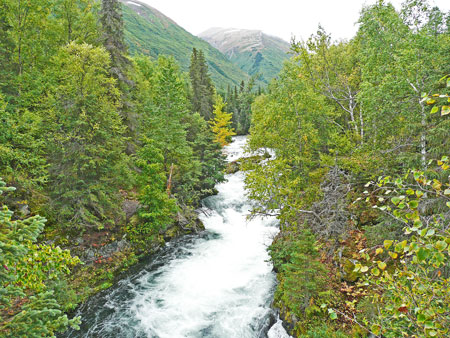
•Return to Anchorage. On our
return to Anchorage we set out to see some moose and/or bear in their
natural surroundings by driving the Skilak Lake Loop Road, 16
miles of pretty good gravel that parallels the Sterling Highway through
the
Kenai
National Wildlife Refuge between Sterling and Cooper Landing. It
is claimed that his area is one of the highest moose-vehicle collision
areas for a rural highway in the state. We drove slowly, as fast a
conditions allowed, but we saw only three other cars and little else.
No
moose, no bears, no deer, no elk, no nothing. That night we camped at
the Russian River National Forest CG, a campground where bears
are attracted by the salmon in the river. In the morning we hiked
a few miles up the river to the cascades to watch salmon
hurling themselves with unbelievable strength and persistence up the
rocks against the force of the river to return to their original
spawning area. (Yes, there really are silver salmon in the water headed
upstream!) There were no bears or eagles to contend with, just
the incredible force of the water that no human could stand against.
Since we had tried our best to
see
big wildlife and
failed, the next day we got to the end of the Sterling Highway (that
runs between Homer and the Seward Highway) and stopped to visit
the Alaska
Wildlife Conservation Center, a 140-acre animal park
with both black and brown bears, caribou, moose, musk oxen, wood bison,
elk, Sitka black-tailed
deer, and eagles. It has the look and feel of a drive-through zoo, but
each of the animals has been orphaned or injured and is there for
rehabilitation. There is a token admission fee to support their efforts
and well worth a visit.
Alyeska Ski Resort is in Girdwood,
a small,
cheerless town that hasn’t seemed to benefit at all from being home to
a
beautiful resort facility, an aerial tram in the off-season, a pleasant
hiking trail through a dense rainforest (the Winner Creek Trail),
Senator Ted Stevens’s remodeled and updated vacation home, and
proximity to Anchorage 37 miles away. There are the usual tourist
traps, including The Great Alaskan Tourist Trap (“located next to the
Ice Cream Shop”). That says it all. Unless you ski, or want to
pay
lot of $$ to hang out in a beautiful and expensive resort, you can
drive close by and never miss anything.
We spent the night in the worst
campground in the
huge Chugach National Forest: Bird Creek. And they charge for it! The
redeeming feature is its location on a paved bike/running path that
goes along six miles of the shore of Turnagain Arm. Judy enjoyed that,
but the dirt road through the campground has pot holes into which even
a 28' RV could disappear. And use a bathroom somewhere else
before you get there; the outhouse facilities are rank! Even the
campground host doesn’t go into them.
III. DENALI NATIONAL PARK
We had planned our trip to meet
up with old friends
from our early marriage years in Boston who live in Anchorage but
were going to be on a trip back to Michigan until Labor Day. We would
get together with them and spend our last days in Denali. When we
turned in the RV the morning after Bird Creek CG, Bob picked us up,
took us to lunch and then to their house on Government Hill that
overlooks the city and Ship Creek. In the afternoon we visited the Anchorage Museum at Rasmuson
Center for an excellent docent-led overview of the settlement of
the
city from the earliest native peoples, the Russians, whalers, and the
gold
rush to the coming of the railroad, the military in WW II and
statehood in 1959. Alaska artists are also on display along with
dioramas and
photography. We shopped the downtown native art shops until dinner.
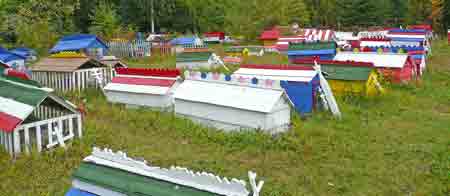
[Note: The
city was established as a railroad construction site in 1914 for the
Alaska Railroad, which was built between 1915–1923. Its original
name was
Ship Creek Landing. It was incorporated in 1920 as Anchorage with a
population of about 1,850. By 1950 there were about 11,000, in 1960
44,000, and in 1990 there were over 225,000 residents. Today there are
over 260,000 people representing many different ethnic groups: nearly
100 different languages are spoken by students in the Anchorage School
District.]
We left the next morning for
Denali, stopping a short way out of town at the Athabascan Village of
Eklutna, home to the Eklutna Historical Park. This small area
is dominated by St. Nicholas Russian Orthodox Church and traditional,
colorfully painted spirit houses marking the graves of both native and
a few
non-native people. Michael and I had visited this site 25 years earlier
and it had stuck in my mind as a unique and memorable cemetery.
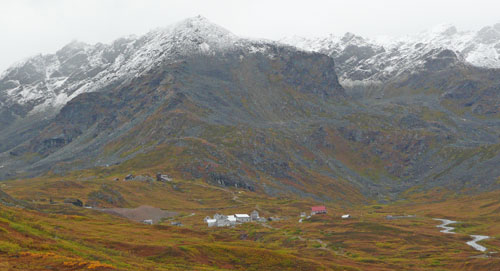
Continuing north, we took a side
route over Hatcher Pass, a
former mining area
surrounded by rugged alpine scenery north of Wasilla and Palmer. The
isolated road is much like it was when mining was in its heyday: a
narrow,
bumpy,
gravel road with switchbacks and potholes, though there are some paved
areas
and scenic turnouts. It follows Willow Creek to the town
of Willow on the Parks Highway. The views were scenic as we hda heard,
the birches were turning golden, and the surrounding peaks were touched
with a light sprinkling of termination dust.
We changed plans regarding our stay in
the Denali area and continued on to Fairbanks for the night. We briefly
stopped to pick some blueberries along the way (the blueberry bushes
stretched for miles on either side of the road); we passed Wall*Mike’s
and Skinny Dick’s
Halfway Inn without stopping except for a snapshot for our records.
We looked hard for the mountains as we passed the
entrance to Denali Park, but the clouds were low and the rain was light
but steady, and we knew that the weather would have to change for us to
take any advantage at all of really seeing the landscape of this area.
[Note: The National Park Service
closes much of the park to visitors in early September (the exact date
varies a little from one year to another). This year, limited access by
shuttle
bus began September 12, the day we were scheduled to arrive. Visitors
are free to hike and bicycle beyond Savage River, but the rest of the
80+ miles is unavailable [most of the year]. This is another good
reason to plan a trip to Alaska between Memorial Day and Labor Day.
There is a 3-4 day period after the Park closes up in early September
when, by lottery, individuals may drive private cars as far as the end
of the road, weather permitting. For information about road closings,
lottery permit procedures, any reservations, and schedules, visitors
should check out Denali
Park’s website.
Better yet, it’s worth a phone call (907-683-2294) to get the latest
and most accurate information.]
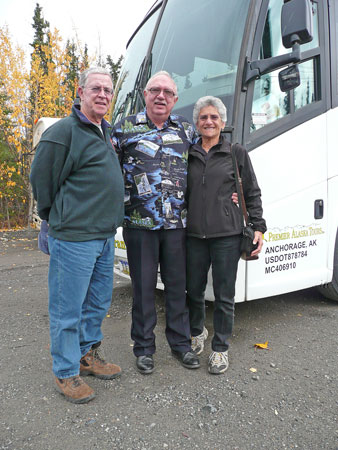
The weather had lifted enough on
our return to Denali NP that just a few short miles into the Park we
caught our first and only glimpse of 20,320' Mt. McKinley (Denali), the
highest point in North America. Because of fickle, unpredictable
weather, most visitors don’t have that opportunity—and our view didn’t
last for long. We pulled over and took lots of pictures while we had
the chance. While they don’t match the postcard photos or ones taken
from a fly-over, we were satisfied. As we pushed on to Savage River,
the end of the road open to us, we were in awe of the fall colors and
the rugged landscape. We would certainly welcome the opportunity to
return mid-summer for a longer period of time to enjoy the wildlife (we
did spot a lone moose crossing the river and watched a family of
ptarmigans on our hike along the river), the pristine scenery hiking in
the
backcountry, and the chance to camp in one of the five established
campgrounds or
backpacking to a place of our own. Reservations are key, as the park is
the most popular attraction in the state. The park is huge
(approximately 6 million acres, about the size of New Hampshire) and
the 85-mile park road offers views of only a fraction of what’s there.
We’ll plan to fly over the park on a future visit.
That same afternoon, we met up with Ron
Holloway, a classmate I was friends with in junior high but who had
moved away our freshman year in high school. He had missed our 50th reunion
last year but he had been tracked down living in Alaska. I had his cell
phone
number and we got in touch with each other and arranged to meet after
54 years! Ron had done a number of things in his life—radio, police
work, and resort management among others—and was now
driving a tour bus throughout Alaska and the Yukon! After over half a
century, our reconnecting was easy, as though the years melted away. We
spent part of an afternoon near the entrance to Denali getting caught
up on each other’s lives since going to school in Ojai, California in
the mid-1950s. We later had dinner together with him and his wife,
Barbara, a long-time resident of Alaska. We wished we’d had more time
with them both. Like revisiting Denali NP more thoroughly on a future
trip, we’ll be sure to spend more time with them.
Upon our return to Anchorage, our
last days were
filled with downtown shopping (Judy found a lovely carved sea otter
fetish carved from a walrus tooth as her memory token of the trip);
visits to the Botanical
Gardens (where everything was damp and little was full flower) and Potter’s
Marsh south of town for wildlife viewing (lots of salmon, some
muskrats, a few ducks, but no signs of bear or moose!) followed by a
short walk along Turnagain Arm. Judy ran each day along an urban
section of the Anchorage Bike Path, a series of connected
paved paths throughout the city.
On our final day Bob drove us to the Alaska Native Heritage
Center, an outstanding “living museum” about the various native
groups. We took a guided tour of the six traditional village settings,
watched dancers, viewed exhibits and demonstrations of traditional
crafts, and talked with native artists working and selling their work.
This was a sampling of Alaska’s native cultures that exceeded our
expectations and should not be missed by any visitor to Anchorage.

IV. SOME
FINAL THOUGHTS
On our foreign trips we know we
only saw and experienced a tiny fraction of a country or area within a
country. Though we spent weeks in Italy, Australia, Tanzania, and
other wonderful places, we saw only a small portion of each country and
realize there was much we didn't get to know. The same is true of
Alaska. Much of the state is difficult to
get to, requiring much more driving—better yet, flying. (Imagine
placing a map of Alaska on top of the continental 48 states: Alaska
would stretch nearly from coast to coast, from border to border!) What
we did see filled our senses (and cameras) with images that were larger
than life: the mountains, the wildlife, the glaciers, the fjords, the
water, the spaciousness, the quiet. It was an amazing three weeks.
Yet we are humbled by how much we
didn’t experience, enough so that we look forward to the possibility of
returning. There is so much more to see in this world, we regret we did
not start our travels earlier in life.

 THE BIG
PICTURE
THE BIG
PICTURE
 As much as we enjoyed our time on
board, we spent all the time we could off the ship when we pulled into
one of the four
ports on the itinerary. The four shore excursions will be what we
will remember most from our week on the Inside Passage.
As much as we enjoyed our time on
board, we spent all the time we could off the ship when we pulled into
one of the four
ports on the itinerary. The four shore excursions will be what we
will remember most from our week on the Inside Passage.








 The next
morning we read the Sunday paper and drank
our coffee in the Safeway parking lot, waiting for the Pratt Museum to
open at 10:00. The Pratt has excellent displays—videos as well as art,
photos,
and artifacts—of native history, sea life, the Exxon oil spill, and
other aspects of life around Homer and Kachemak Bay. The docent at the
adjoining pioneer cabin was entertaining as well as informative. All in
all it was time well spent. The few art galleries open were worth the
visit, as was a heath food store on the main street.
The next
morning we read the Sunday paper and drank
our coffee in the Safeway parking lot, waiting for the Pratt Museum to
open at 10:00. The Pratt has excellent displays—videos as well as art,
photos,
and artifacts—of native history, sea life, the Exxon oil spill, and
other aspects of life around Homer and Kachemak Bay. The docent at the
adjoining pioneer cabin was entertaining as well as informative. All in
all it was time well spent. The few art galleries open were worth the
visit, as was a heath food store on the main street. 





